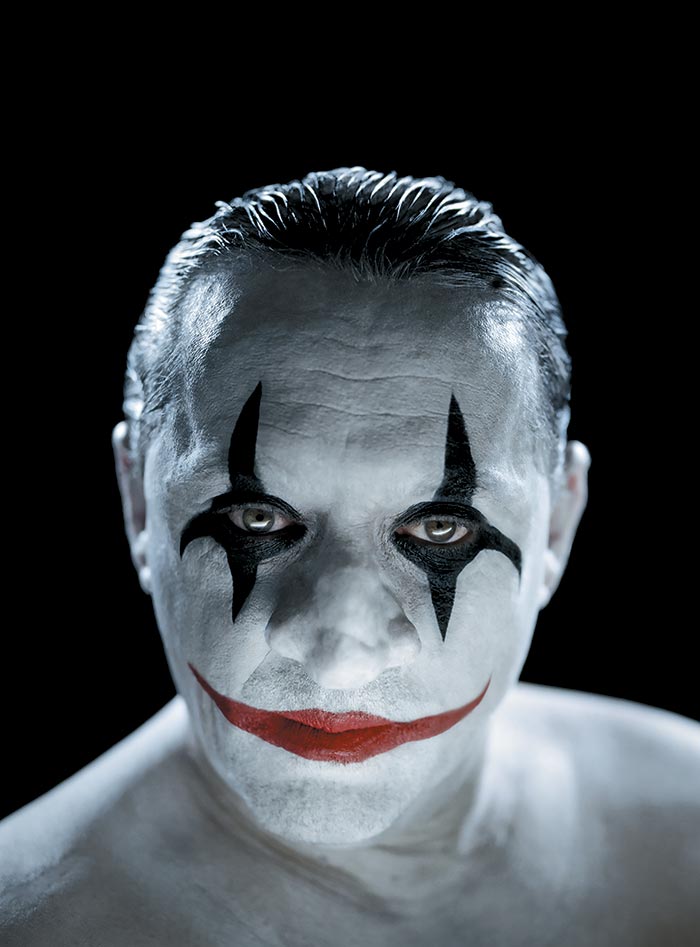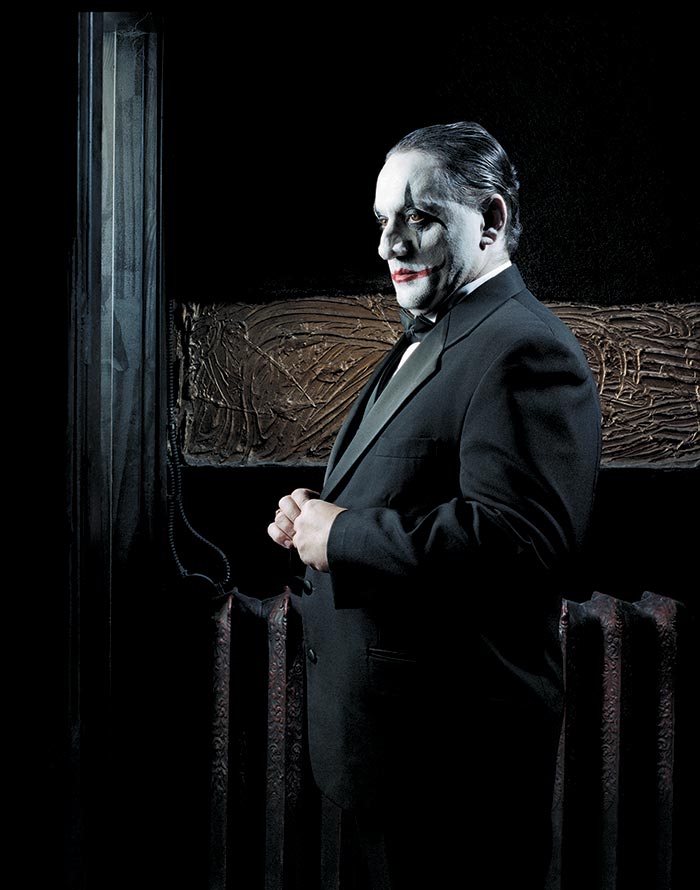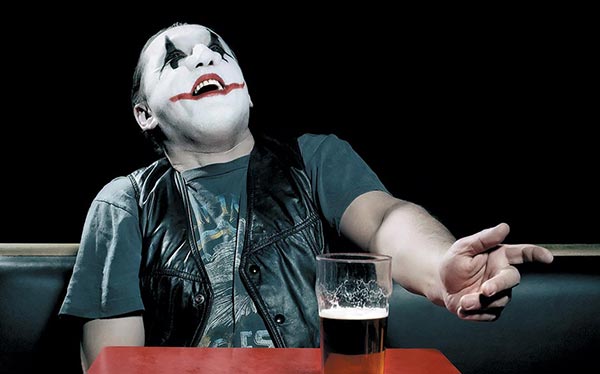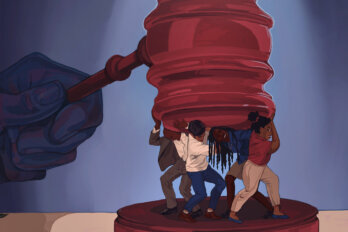As unlikely as it may seem, the ex-clown pictured opposite is Canada’s most prolific, most successful and, arguably, most reckless undercover agent. His nom de guerre is John Holloway and the final act of his lengthy career as a mercenary on the rcmp’s payroll was slated to take place in a Winnipeg courtroom early on October 22, 2004. That morning, a sharp wind cut across the courthouse on the city’s famed Portage Avenue, warning of the inevitable arrival of winter. Bands of smokers shuffled about, shoulders hunched against the chill, unaware of the drama that was about to unfold inside.
Holloway had been summoned here to testify against the prime target of his last undercover caper: Frank Nucci, a local boy turned drug trafficker with ties, cops say, to Italian organized-crime families and bikers. The subpoena was an unnecessary legal formality since Holloway was anxious to confront Nucci and point an accusatory finger at the short, heavy set, nattily dressed gangster who had been mistakenly convinced that his former friend was also a loyal comrade-in-crime.
Although Holloway wanted no part of it, the Mounties were determined to shield their man from Nucci’s wrath, sequestering him for the preliminary trial in a nearby police barracks rimmed with barbed wire and assigning three well-armed officers to escort him in and out of court in a bulletproof vest. On the eve of his testimony, however, Nucci unexpectedly waved a white flag and pleaded guilty to drug charges, denying Holloway the opportunity to end his days as an agent on a salutary note.
“He did a very good job,” says rcmp constable Giovanni Persichetti, Holloway’s minder on the Nucci investigation. “I think he was upset because he wanted to finish the job in court.”
Holloway’s disappointment was fleeting. “He took a plea. Fine by me,” he says matter-of-factly. For Holloway, Nucci was the final notch on his long belt of victories over crooks. Indeed, Holloway has spent hundreds of hours in court facing down an unsavoury assortment of targets, quietly relishing each confrontation as a fitting denouement to his subterfuge.
In a precarious business where the shelf life of an agent is usually measured in weeks or months and one or two undercover operations, Holloway’s assignments stretched over nearly a decade and involved members of the Cosa Nostra, biker clubs, drug cartels, Chinese gangs, even a dirty police officer who threatened, he says, to put a bullet in his head. His undercover work took him from Vancouver to St. John’s and several small and large cities in between.
Holloway was paid handsomely in exchange for services rendered. The investment paid dividends, with Holloway helping authorities to secure scores of convictions, mostly involving drug traffickers, including three dealers working out of a community centre in a small southwestern Ontario town. But the clandestine work, however lucrative, also nearly cost Holloway his life. He narrowly survived exposure of his true identity, suffered a near-fatal beating at the hands of suspicious drug dealers, and contracted a potentially deadly form of hepatitis along the way.
Given the arc of Holloway’s career, it is not surprising that enemies like Frank Nucci abound. What is startling is his perplexing decision to forgo repeated police offers for witness protection, where ex-agents are offered a chance of a new life with a new name, a new home, and a new job. Holloway has rejected it all, choosing instead to visit family and friends regularly and to live and work under his real name in a rural Ontario town close to where he recently participated in an undercover operation.
“People that hide are ashamed,” he says angrily. “I’m not fucking running from anybody. And what are they going to do when they find me? Kill me or die trying.”
Holloway’s defiance is either the stuff of movie heroes or a stupefying death wish. It is also, without question, a measure of a man who was prepared to take extraordinary risks not only in the undeniable pursuit of a healthy payday, but ultimately as a means of redemption, perhaps even salvation, from the troubling echoes of his past.
“I really don’t know why you’re interested in me and all this. Frankly, I don’t understand why anyone would even give a shit,” Holloway snaps. Sitting in the antiseptically clean kitchen of a spacious, well-appointed bungalow he shares with his long-time girlfriend and Milton, his cherished dog. Holloway looks ill at ease. A diminutive, middle-aged, and still powerfully built man with a thick mane of brown hair and a magnetic smile, he agrees to talk for the first time about his undercover work.
Holloway’s seeming reticence to discuss his past has a disingenuous ring to it. Beneath the taciturn veneer lies an adept performer who is acutely aware that one’s identity can be fashioned to conceal motives and the truth.
At first, Holloway plays the part of the reluctant, mildly irritated subject of a reporter’s interest, offering up half- hearted, cryptic answers. Eventually, his reserve fades and another, less calculated figure emerges. His storytelling becomes more fulsome, his cadence quickens until he catches himself almost delighting in recalling his escapades. Then, unexpectedly, Holloway pauses. His face becomes taut as he leans forward. “I remember a baby,” he says without a hint of affectation. “She was ten months old and about seventeen pounds. Her mom was a crackhead and giving a guy a blow job. I said, ‘Jesus, cover the kid up, she’s freezing.’ Her mom said she was asleep, but when I went to pick her up she was toast, starved to death.”
Holloway insists that his work was “never personal,” that he was paid to do a job with no emotional strings attached. But in recounting the story of the dead child, Holloway reveals something of himself—that his attitude towards the many casualties and culprits he encountered during his career was very much “personal” and it imbued all that he did as an instrument of the police.

Holloway was born in the coal-mining town of Sydney, Nova Scotia, in the late 1950s. His parents meandered through a spate of poorly paid jobs before heading to Toronto in 1965 in a futile search for a better life.
Holloway’s youth was unremarkable, save for losing the sight in his left eye owing to a friend’s schoolyard prank. It was his father’s volcanic temper— stoked by booze and poverty—that left the most enduring emotional scar. “It was rough,” he says, recalling the drunken tantrums and beatings. Holloway escaped into the thrilling world of comic books where heroes were forces for change and for good.
At seventeen, he abandoned home and school in pursuit of adventure and money. Holloway also discovered drugs. A long, disastrous addiction began with pot and hashish, and eventually turned to harder drugs. His fondness for a dope-fuelled good time was satisfied when he began working for rock bands that criss-crossed North America. The sex and drugs were plentiful and cheap.
Four years later, Holloway tired of the rock-and-roll lifestyle and, on a whim, took up jobs as a performing clown. He enjoyed hiding behind a painted-on face, discovering a gratifying sense of freedom in anonymity. During a stopover in Arkansas, Holloway met his future wife. The young couple returned to Canada and Holloway became a trucker. Later, when the marriage dissolved, Holloway moved to Barrie, a town just north of Toronto, where, by the early 1990s, he had helped build a successful trucking company that sustained his passion for fast cars, women, and, of course, drugs.
Holloway’s spending sprees attracted the attention of the Toronto-based Para-Dice Riders (pdr) biker club. At the time, some members of the pdr living in Barrie were also moonlighting as truckers and, like Holloway, they were regulars at local strip clubs. Holloway and the bikers gravitated to one another.
Cocaine was now Holloway’s drug of choice and the pdr were his first suppliers. “I started and I couldn’t put it down,” he says. His habit mushroomed, reaching a $1,500-a-week price tag, the drugs consuming Holloway and, eventually, his business. Broke, he moved to Hamilton and fell more deeply into drugs, turning cocaine dealer for local doctors, lawyers, and businessmen to finance his own voracious habit. The precipitate descent from thriving entrepreneur to cocaine addict had occurred in less than a year. It was about to get worse.
In late 1994, Holloway was busted. He was swept up with other dealers in an undercover probe spearheaded by Hamilton police. Days later, he agreed to do “a patch” (co-operate with police). “It was all about protecting my ass,” Holloway admits. The trafficking charge disappeared, and his career as a police agent had begun.
Holloway’s “patch” with the police has been struck countless times by crooks and cops. Each side in this shotgun marriage knows that the tie that binds them is not affection, but expediency. For the police, agents like Holloway offer the irresistible prospect of headline-grabbing arrests. For the convicts-turned-agents, the union not only keeps them out of jail, it holds out the most tantalizing lure of all—money.
Like any real marriage, however, there is always the risk of divorce. The tenuous trust in this makeshift relationship can abruptly dissolve when the balance between the partners’ interests tips dramatically in either direction.
Holloway and his handlers would often test that delicate balance. Ultimately, they understood that success or failure would depend on their faith in one another and their ability to exploit each other’s strengths, vanities, and weaknesses.
For Holloway, the metamorphosis from drug dealer to police agent was quick and seamless. The addicts, pushers, hoods, pimps, and prostitutes who were his former accomplices were now his unsuspecting quarry. He was eager to deceive as many of them as possible in order to please his paymasters and enrich himself.
Having hooked Holloway, the Hamilton police wanted him to dive headlong into Project Driver, a dormant undercover investigation that targeted street drug dealers in the gritty, perpetual poor cousin to Toronto. The rcmp also wanted a piece of the catch, knowing that the ex-trucker was close to a major liquor smuggler with links to organized crime who had eluded them for years. Holloway knew he had little choice but to assist both police forces. Call it multi-tasking undercover-style.
“Be cool and do what you do,” Holloway’s handlers told him before thrusting their newly minted weapon onto the street, where he promptly began scoring dope and handguns from a bevy of dealers whom police later arrested.
Despite his early success, Holloway feared that he would not emerge from Hamilton alive. In his mind, the threat came less from the dope pushers than from rogue members of a municipal police force with a reputation for corruption. His fears would prove prescient.
Constable Bruno Silvestri, a short, balding veteran undercover narcotics officer was Holloway’s primary contact throughout Project Driver. Initially, Holloway enjoyed Silvestri’s company, instantly befriending the amiable, married father of two young children. For his part, Silvestri soon broke a cardinal rule of the police/agent relationship: he got too close to Holloway, confusing a friendship of convenience for unquestionable loyalty.
While Holloway and Silvestri trolled Hamilton’s streets, disturbing things began to happen. Silvestri, Holloway says, bought handguns without reporting the purchases to superiors and pocketed thousands of dollars earmarked for drug buys, sure that his undercover companion would remain silent.
For a time, Holloway kept his mouth shut, not out of any sense of fealty towards Silvestri, but as an act of self-defence. Holloway knew that in many cops’ eyes he was, though useful, still an untrustworthy rat. To blow the whistle on a cop so early in his career as an undercover agent would be met with disbelief or worse. Holloway chose instead to wait and build up his credentials with other handlers, hoping that eventually he would be heard and believed.
In July 1995, the Mounties had Holloway infiltrate the mob-connected liquor-smuggler’s operation based in Barrie, Ontario. Since the trucking industry was familiar terrain, Holloway easily got himself hired as a part-time dispatcher for the target, reporting daily to the Mounties on his movements and schemes.
Another arm of the Mounties then recruited Holloway to salvage a lengthy drug-trafficking probe that had disintegrated into a public fiasco. The original six-month undercover probe, code-named Project Ice, had targeted high-ranking Para-Dice Riders. The first undercover agent, Cory Privitera, was a borderline psychopath who later turned into every handler’s nightmare—going public with claims that he committed extortion, assault, even murder while working for the Mounties. Privitera appeared to have duped several senior Para-Dice Riders, along with at least thirty-five others who were indicted on drugs and weapons charges. But the charges were withdrawn and the accused set free when Privitera was implicated in the drug-related death of a sixteen-year-old boy.
Project Ice had imploded and the discredited agent had gone into hiding before committing suicide by firing a flare gun into his head. Enter Holloway and Project Twice. The new project’s “marks” remained the same. It was Holloway’s job to clean up the mess left by Privitera and to “seal the deal.”
“They [the rcmp] had found a well and they were determined to get every drop out of it,” he says of the Mounties’ thirst for his services. In fact, Holloway seemed poised to become a super-mole and he was anxious to cash in, striking new deals with the Mounties for at least six other projects, including infiltrating a Greek-run cocaine ring and squirreling an rcmp officer into a Toronto-based smuggling operation headed by a Colombian with ties to major drug-trafficking syndicates in Central and South America. The frenzy of undercover jobs meant the money kept rolling in. “In for a nickel, in for a dime,” Holloway laughs.
Through it all, Holloway relied heavily on his street smarts, innate fearlessness, and chameleon-like nature to dupe the bad guys who were, in his view, mostly gullible stooges. “It was an unbelievable feeling knowing they [the targets] were going down.” That “feeling” was Holloway’s fresh addiction and it needed to be satiated time after time.
The police were Holloway’s de facto “dealers,” controlling his supply to the potentially lethal “drug” he was now hooked on. Clearly, there were dangers inherent in the potentially volatile relationship. If Holloway stumbled badly or relapsed, the undercover operations were likely to crumble; conversely, the police risked alienating Holloway by assigning inexperienced or impatient handlers to his cases.
One of Holloway’s early and most trusted rcmp contacts agrees that police were well aware that their “super-mole” had become dependent on the rush he derived from the undercover operations and that they fully exploited his dependency: “He wanted to be the best and busiest agent this country has ever seen.”
Beyond the money and the adrenaline high, the Mountie explains, police also understood that Holloway was motivated by another, even more powerful impulse: vengeance. Holloway believed drug dealers had ruined his life and now he was in a position to exact a satisfying measure of retribution. “His motive was revenge,” the officer says bluntly. “He was out to make sure they didn’t do it to anybody else.” The little boy from Cape Breton Island who still inhabited Holloway’s soul believed that he was living out the fantasy world of comic-book heroes he had once so admired: helping rid the world of evil—for a hefty paycheque, of course.
Evil comes in many forms and it often arrives unexpectedly. In early February 1996, Holloway’s pager flashed an urgent message from Michelle, a Toronto prostitute he had once offered safe haven from her pimp. It turned out that she had just stabbed an east-Indian “John” to death with a steak knife. “He wanted to do it one more time but didn’t want to pay any more money, so she fixed that,” Holloway chuckles. Frantic, she pleaded for his help, tearfully describing what she had done and when and where she had done it. Holloway called his handler and told him to go to a home near the city’s airport where police discovered the man’s body, covered in a blood-soaked blanket. To protect his cover, police briefly detained Holloway.
The incident and Holloway’s reaction to it reflected the schizophrenic nature of his work. On the one hand, he had to report the murder to authorities, but part of him also felt sympathy for Michelle, a young woman who sold her body to feed a life-draining drug habit that Holloway had once shared. He knew the ugliness that drugs and dependency can breed, but he also understood that he was powerless to do anything about someone else’s addiction.
That Holloway had confided in his handler at all was also evidence of the changing mettle of the relationship. An association born of necessity was moving towards a bond forged by shared experiences, demands, and pressures. Their faith in one another was deepening. Just weeks after the murder, Holloway and his handler boarded a Canadian Airlines flight bound for British Columbia. The hastily arranged trip was the result of the Mounties’ near-absolute confidence in Holloway, who was keen to earn more precious brownie points and another thick wad of cash.
Holloway was instructed to make a buy from a heroin-trafficking ring based in Vancouver believed to be operated by the Big Circle Boys, a notorious Chinese organized-crime syndicate with tentacles throughout Canada. The pair arrived on a Friday morning and less than thirty-six hours later, Holloway had scored four ounces of high-grade heroin from a dealer on a bustling Vancouver street corner.
The speed with which Holloway set up the buy underscored not only his ability to penetrate any city’s subterranean drug culture, but his ruthlessness. His in was a local heroin addict whom Holloway browbeat relentlessly, offering her money in exchange for a meeting with her dealer. After enduring a torrent of obscenities and insults, she reluctantly gave up a name. “I can be a bully when I have to be,” Holloway acknowledges.
A local female Mountie posed as Holloway’s “bitch” and accompanied him to make the buy, while his handler provided cover. The gang member hopped into the front of Holloway’s rented Chevrolet Cavalier and in exchange for $4,400 an ounce, handed over the drugs. When the Big Circle Boy began counting the money, Holloway exploded.
“Why are you counting my money? I didn’t weigh your dope. You don’t think I have any honour,” he shouted. The Chinese gangster apologized and gave Holloway his phone number, allowing local Mounties to keep track of him. Holloway returned to Barrie, where he learned that the principle target of a liquor-smuggling operation was preparing to import a whopping 250 kilos of cocaine from Ecuador into Canada dissolved in liquid soap. Major drug syndicates often employ chemists who can alter the chemical composition of cocaine to transform it into a benign-looking substance only to reconstitute it once it has reached its intended destination. Holloway had successfully planted a Mountie, with a background in chemistry and posing as a biker, into the smuggling operation. The Montreal police later intercepted the “soap” shipment and the rcmp finally collared the trafficking kingpin.

The wispy haired, tattoo-laced Mountie, who briefly slept with a shotgun in his bed because of mob contracts on his life, credits Holloway with the arrest and seizure. “The investigation wasn’t going anywhere,” he says, lighting up a cigarette. “He has put people away that we probably would have never put away.”
Holloway’s secret work and the avalanche of intelligence he generated bore more fruit on the Canada Day long weekend in July 1996. Police forces from Ontario to British Columbia unleashed a swarm of officers to round up the targets, including a batch of top-tier Para-Dice Riders. In all, police made over 120 arrests across the country on a raft of drugs and weapons charges mostly stemming from Project Twice and Project Driver.
In all, he was paid over $200,000 plus expenses for his work on Project Twice and Project Driver. Holloway says that much of the money was used for family gifts and holidays, while the rest was deposited into a former girlfriend’s bank account.
The financial windfall came at a stiff cost since Holloway was now very much a wanted man. The Mounties whisked him into a London, Ontario, hotel room before moving him temporarily to Winnipeg for safekeeping. For a few days, he let a soothing relief wash over him, indulging himself in a comfortable hotel room before he became lonely and bored. The tedium was relieved when he returned to Barrie several weeks later to testify against the pdr and the other targets of Project Twice. “I saw the pussy, cry-baby, scared-of-their-own-shadows-unless-there-are-four-of-them-together bastards that they are,” he says. “I smiled at them and they just looked away.” And unlike Cory Privitera’s, Holloway’s testimony stood up, allowing the charges and the convictions to stick.
As he basked in the triumph over his adversaries in court, Holloway’s unimpeachable performance enhanced his standing in his handlers’ eyes. But his credibility was about to face its stiffest challenge yet. He had taken the stand to confront bikers; now he was poised to confront a cop and trigger one of the biggest police-corruption scandals in Hamilton’s history.
As another court date loomed, this time for Holloway to testify against targets of Project Driver, he faced a dilemma: either expose Bruno Silvestri, the dirty Hamilton vice-squad officer, or stay silent and risk Cory Privitera’s ignominious fate.
Holloway’s instinct for self-preservation won out and, confident that he would be believed, he told his rcmp handler that Silvestri’s notes were inaccurate and he described the police officer’s dubious modus operandi. Later, Holloway videotaped a statement as “insurance” should he suddenly disappear.
Convinced that Holloway was telling the truth, police hatched a plan to use him to catch Silvestri making incriminating statements on tape. The setting for the trap was the police “ready room” at the Hamilton courthouse, where Silvestri and Holloway, wearing a wire, sat side-by-side, preparing to give testimony. A female rcmp undercover officer, posing as a Crown attorney, was also in the room monitoring the exchange. Sitting in a van outside the courthouse, senior Hamilton police listened intently.
Holloway got right to the point, telling Silvestri that he had “a problem” testifying in the case because of serious gaps in the police officer’s notes. Silvestri leaned towards him, Holloway says, and warned him that his story on the stand had better match his own or “I have a bullet for you.”
With that, Holloway calmly walked out of the ready room and into a waiting van, while Silvestri was immediately arrested by two Mounties. “Get me the fuck out of here,” Holloway barked at police as they hustled him to a nearby hotel.
In early January 1997, Silvestri was charged with several counts of theft, fraud, counselling perjury, and breach of trust. Newspaper accounts of the arrest trumpeted the fact that the probe into Silvestri was the result of “a tip” from an unnamed “police agent.” After Holloway testified at his preliminary hearing, Silvestri resigned from the force. In September 1998, the disgraced police officer cut a deal and received a conditional discharge after pleading guilty to one charge of theft under $5,000, thus avoiding a jail term and a criminal record. (As a result, many of the charges stemming from Project Driver had to be withdrawn.)
Holloway insists that his role in the unmaking of Bruno Silvestri was just business—nothing more, nothing less. And business for the busy soldier of fortune was good. His next stop was Chatham, Ontario, the kind of unremarkable town that dots the pastoral landscape of southwestern Ontario. Dig a little deeper though and another, less appealing truth emerges. The town of 44,000 is infected with prostitution and drugs, where, beyond cocaine and crack, dealers offer up prescription narcotics for sale, drugs like synthetic heroin (used to treat cancer patients), morphine, and Percodan, a powerful painkiller.
Holloway had little trouble making his first buy on the first day of the undercover investigation—code-named Project Stinger. He also learned that the Rock Machine, a Montreal-based biker club, was trying to make inroads into the drug trade in southwestern Ontario and to establish ties with powerful regional biker clubs.
Spanky’s, a popular strip club in town, was effectively Holloway’s workplace, where he befriended dealers and members of the Rock Machine. His cover story was simple: he was a supervisor for Canadian National (CN ) railways who had recently transferred to the area. To cement the ruse, his handler gave him a CN pick-up truck and ID tags. The bikers bought it. “They were as dumb as hammers, but they were ruthless. They would kill you and sit on your body and eat lunch,” he says.
Soon Holloway was buying dope from the Rock Machine bikers and from other dealers working out of several unlikely places in town, including a local union hall and a busy community centre that housed a daycare facility where police had sponsored various events designed to show children there were ways to have fun without substance abuse.
The six-month probe ended successfully in June 1997 with police scooping up twenty-three dealers and seizing about $300,000 in drugs. Local newspaper stories praising the busts gave much of the credit to an unnamed “police agent,” and Holloway was happy to pocket his $30,000 ( plus expenses) and a $500-a-week living allowance before moving on to the next caper.
Luck is a precious commodity, particularly in the dangerous underworld inhabited by undercover agents. The longer they remain active, the greater the chances that their luck will finally run out, perhaps with deadly consequences. It was a risk that Holloway and his handlers were still prepared to take as he entered his fourth year of covert work. To this point, luck had been on their side. That was about to change.
Holloway packed his bags in August 1997 for an operation in Sudbury, a rough-and-tumble mining town in northern Ontario. His mission was to get close to a top-tier member of the Hells Angels, one of the most powerful criminal organizations in Canada with a singular reputation for brutality.
Posing as a trucker, Holloway spotted the target at a local country-and-western bar and struck up a conversation, careful not to tip his hand. Other meetings at bars and strip joints followed that summer, but the biker remained tight-lipped. Hungry for results, his new handler had Holloway buy dope from crack dealers and unscrupulous doctors peddling prescription drugs. Suspicions about who Holloway was swept through town. “Dealers started seeing me with the bikers and wondered why I was dealing with them when I could get all the dope I needed from the Angels. That’s what cops do. But when you’re told to do it, you do it.”
One evening, while he stood at a bar cradling a drink, a Hells Angel approached, offered him a beer and then called Holloway by his real name. All of Holloway’s bluster and angry denials could not mask the obvious: he had been found out. When two more Hells Angels sauntered into the bar, Holloway slipped out through a side door. The project in tatters, he hurriedly left town the following day, thankful to be alive. Precisely how the bikers unearthed his identity remains a mystery. Holloway believes that a stripper, who knew he had testified against the Para-Dice Riders in Barrie, had spotted him in Sudbury and tipped off the Hells Angels.
Hoping that a change of scenery might alter his luck, the Mounties sent Holloway to St. John’s, Newfoundland, in the spring of 1998. The operation, code-named Project Blindside, began well, with Holloway buying half a pound of cocaine from a member of the Bacchus biker club, an affiliate of the Hells Angels based in nearby New Brunswick.
It didn’t take long for local pushers to realize that since Holloway was buying large quantities of “gear” (local slang for dope) but not reselling it, he might be a “narc.” Holloway pleaded with his inexperienced handler to let him leave town for a few weeks in vain. Retribution was swift. Holloway was drinking at a bar called The Cotton Club when, without warning, two dealers set upon him like a pair of pit bulls. “They pounded me,” he says. (The beating left him, hospital records show, with a punctured ear drum, a concussion, and a fractured skull.) Dazed and bleeding, he stumbled to the bar and asked to use the phone.
“Who do you want to call? ” the bartender asked.
“The rcmp because that’s who I work for,” Holloway replied.
His stunned handler raced to the bar and rescued him.
Holloway’s luck seemed to have run dry. The work was beginning to exact a heavy toll—emotionally as well as physically. For over a year he returned to the reassuring monotony of truck driving. Then the undeniable urge to get back to undercover operations prompted him to agree to another assignment in early 2000 to infiltrate what the Mounties suspected was a cocaine ring being run from a Winnipeg auto-body shop operated by Frank Nucci. Holloway made several large drug buys from Nucci, who was later charged.
At Nucci’s preliminary hearing, Holloway insisted that the screen set up in court to protect his identity be removed. It was a cocky display of contempt for Nucci and his associates. “Fuck ’em,” he says.
Holloway had been able to stare down many drug dealers in court, but his career as an agent would come to a sudden halt because he was unable to stare down his own demons.
During a follow-up undercover project near the Detroit/Windsor border in 2001, Holloway went awol. “I had a bad time,” he says. “I relapsed.” For weeks, he disappeared into morphine-induced stupors. He had succumbed, Holloway admits, to a temptation that he had never really beaten. That, coupled with a brewing loneliness and ready access to the powerful narcotic, doomed him. “It gets very easy when you’re around it all the time,” he says.
The effect of Holloway’s relapse was clear and immediate: his days as an agent were over. “I told them [the police] I was done. I couldn’t do it any more.” The thrill of the conquest was gone, he claims, replaced by a yearning for a simpler, less debilitating way of life. Holloway says that he has been drug-free since and he will never work as an agent for the police again.
rcmp constable Giovanni Persichetti is not convinced. The veteran cop believes that the quiet, small-town existence his friend now enjoys will lose its appeal. Inevitably, he says, Holloway will say yes when the Mounties come calling—as they likely will—because he still craves the attention, money, and intrigue. “I think something, some day, will bring him out of retirement,” Persichetti says, smiling.
Whether he’s right about how Holloway will answer that call remains to be seen. Holloway has built a new life for himself, far from the unseemly, duplicitous netherworld of dealers, drugs, and mobsters. His days are filled with long, hectic hours as a truck dispatcher, sobriety, and a newfound spiritual bond with the secretive fraternity of Masons.
Holloway cannot, however, entirely cleanse himself of his addiction to undercover work and the money it generates. For a large fee, he routinely passes on his wisdom and experience to handlers-in-training at police colleges throughout Canada.
As for his future, Holloway remains philosophical. “I will get my due, good, bad, or indifferent, but I will get it.”





